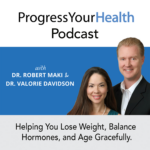
 In this podcast, we talk about the difference between PMS (premenstrual syndrome) and perimenopause. We get this question all the time, Doc, I think I am going into menopause.’ When really, they are nowhere near menopause, let alone perimenopause. What makes it so confusing is that there are so many similarities between PMS and perimenopause.
In this podcast, we talk about the difference between PMS (premenstrual syndrome) and perimenopause. We get this question all the time, Doc, I think I am going into menopause.’ When really, they are nowhere near menopause, let alone perimenopause. What makes it so confusing is that there are so many similarities between PMS and perimenopause.
But some distinctions are important to point out, especially when it comes to testing and treatment. PMS (premenstrual syndrome) is pretty much as it sounds. Symptoms appear prior (pre) to the period (menses). But usually, the symptoms appear in a cyclical pattern.
The symptoms will appear anywhere from 14 days to just a couple of days before the period. The distinction between PMS and perimenopause, is the symptoms are present all month in perimenopause.
Perimenopause is NOT menopause. It is the time before a woman enters menopause. It can be anywhere from age late 30’s to late 40s. In perimenopause, you are still getting your period (it might be irregular, but you are STILL getting your period).
But the symptoms between PMS and perimenopause are similar.
So just to reiterate:
Symptoms that are similar in PMS and perimenopause:
Symptoms that are different between PMS and Perimenopause
Okay, we don’t want to bore you here. But we want to describe what happens in a female menstrual cycle. Just to give you an understanding of what might be happening hormonally in PMS and perimenopause.
In both PMS and perimenopause, unless you have had your uterus removed (hysterectomy), you will still be having a period. This part is written in a perfect 28-day cycle,” which we know that not everyone has a 28-day cycle. It is common and perfectly healthy to have anywhere from 25 to 35-day cycles.
For physiology sake, I am going to describe a 28-day cycle.
Issues that can go wrong with your cycle:
This is the interesting part. There are areas and places in the 28day cycle that things can go wrong.
Progesterone: In both perimenopause and PMS, the progesterone will drop in both PMS and perimenopause. This drop in progesterone can create a lot of the issues that women experience in PMS and perimenopause.
Estrogen: In perimenopause, the estrogen drops slightly. But in PMS the estrogen does not drop. In fact, estrogen can be high (estrogen dominance) in PMS. But in perimenopause, the estrogen declines a slight amount.
Insulin and Cortisol: When there is estrogen-dominance or progesterone-insufficiency, insulin and cortisol have no buffer. Again, I don’t want to bore you with physiology. But when there is stress, it raises the cortisol. A rise in cortisol will cause an immediate surge in glucose. An increase in glucose will cause the pancreas to secrete insulin. Insulin is important for glucose to be facilitated into the cell.
But insulin is the only fat storing hormone. Example: you are sitting at your desk. You get some stressful news. This stressful news will cause your cortisol to rise. This sends a signal to cause a rise in glucose (even though you didn’t eat anything). The increase of glucose in the bloodstream will cause the pancreas to release insulin. But you are still sitting in your chair. You are not running from a bear or threatening situation. The result is the insulin allows the glucose to enter the cell and then get stored as fat. Yes, stress can make you fat. As mentioned above, when you are not in perimenopause, the hormones (estrogen and progesterone) help to buffer the effect of excess cortisol, insulin, and glucose.
That is why when you are 22 years old you can get 5 hours of sleep, work two stressful jobs, go to school and eat burgers and milkshakes without missing a beat or gaining weight. When you are 46 years old, and on Sunday eat a dinner of Mexican food, skipping the chips and salsa (maybe one glass of wine). Come Monday, you slept terribly and wake up 3-5 lbs heavier (and boy, do you feel it!).
Now, the difference between perimenopause and PMS is, in PMS this insulin issue happens during 3-14 days before your period. But in perimenopause, this is an issue the entire month.
Thyroid: Now we cannot forget the thyroid hormones when comparing perimenopause to PMS. The thyroid is a whole different animal in terms of hormones. Low thyroid can actually cause exaggerated PMS. So if your PMS is pretty bad, please have your thyroid levels checks. And if you have low thyroid or Hashimoto’s, your PMS can be intense, but that is another blog itself. But to keep it simple, in PMS the thyroid is not as much of an issue as it is in perimenopause. The thyroid function itself can decrease with time/age. In perimenopause when the progesterone has dived, and the estrogen is present but slightly decrease. This can cause a lot of pressure on the thyroid, causing the thyroid function to drop.
Androgens – Testosterone and DHEA: In PMS and perimenopause, there are complaints of feeling irritable, acne and hair loss. Now, this is not the complete answer, but it can be due to androgens. Testosterone and DHEA are both androgens. Men have quite a bit more androgens (testosterone and DHEA) than women. But if the other hormones are not balancing the androgen, you can have symptoms of high androgens. In PMS, anywhere from 3-14 days before a period, the low progesterone cannot buffer the androgens. In perimenopause, the lower hormones cannot buffer the androgen all month long. Hence, feeling testy, acne and hair loss can occur at this time.
Hormone Lab Testing:
After reading all of this, you might be wondering: How do I test if I have Perimenopause or PMS? While I cannot speak for most doctors, I will tell you how we test for PMS and perimenopause
Blood Test: We have been using blood testing for many years. But as mentioned above, in perimenopause and PMS the hormones are changing daily. I like to test the blood from day 19-25 of the cycle. If you test earlier in the cycle, the progesterone might not be accurate. I like to test, FSH, LH, Estradiol, Progesterone, DHEA-s, Testosterone, Pregnenolone. I will explain in another podcast, what the levels should be, and what the pregnenolone means:)
What happens if I’ve had a hysterectomy and cannot know what day of the cycle I am in? Then we just tell them to test any time of the month, and from experience, I know where they are in their cycle and where the levels are at.
Saliva Test: Saliva testing is common and extremely sensitive. So you can really get a measure of where the hormone levels are at using a saliva test. But the drawback is for me, the saliva tests are too sensitive. So when someone is on hormone therapy/BHRT, the saliva test is so sensitive the levels read extremely high. This makes it hard to dose a woman’s hormone prescription, supplements, glandulars on a saliva test as the levels can be hard to interpret.
DUTCH Test: The DUTCH test is very popular right now. And they are really amazing and can provide a lot of information. Unfortunately, a lot of doctors will order the test and do not know how to interpret the results or provide recommendations based on the results. DUTCH tests do not test progesterone. But they do test progesterone metabolites that can be an accurate reflection of progesterone levels. The one really great key value in a DUTCH test is the estrogen metabolites. There are no other tests out there that can give such an accurate measure of estrogen metabolites. DUTCH tests are not usually covered by insurance and can be a bit pricey out of pocket.
Unfortunately, there are not a lot of options to treat PMS or perimenopause conventionally. If you go to your PCP, general practitioner, gynecologist, the most common options are birth control pills, antidepressants and/or an IUD or perhaps anti-anxiety meds. But there are many healthy, natural options for both PMS and perimenopause. In the future, we will go into more depth and also options to help to alleviate the symptoms.
We hope this podcast shed some light on the differences between PMS and perimenopause. Any questions or concerns, please feel free to post a comment below or send an email to [email protected]
The post Perimenopause or PMS? | PYHP 056 appeared first on .
Discover the common and unfamiliar symptoms that you might be experiencing. Get access to cases of real women with hormonal conditions.

In this episode, we return to a listener’s question regarding thyroid dosing in perimenopause. In our previous episode, we answered Tracy’s question about taking estrogen in perimenopause. Tracy also asked us an additional question about her thyroid doses. Tracy does not have a thyroid gland and has been noticing her dose is continually increasing as […]
In this episode, we discuss a listener’s question regarding perimenopause and estrogen hormone replacement. Tracy is concerned because she is still having a period but also has symptoms of low estrogen. She is not sure if she is a candidate for estrogen therapy since she is still cycling. Tracy’s Question: Hi- you’ve discussed in past […]
In this episode we discuss Jenell’s question she submitted on our website (Ask the Dr). Jennell has been having terrible anxiety since entering menopause and it is really affecting her quality of life. Jenell’s Question: Since starting menopause, I’ve had debilitating anxiety, especially bad in the morning. By evening, It practically goes away. I’m 54 […]
In this episode, we discuss a listener’s question. Amanda is 50 years old and starting to have menopausal hot flashes and weight gain. However, she is most concerned about the heart palpitations she is having. Amanda has had a cardiovascular workout and does not have heart disease. Most people might not be aware, but feeling […]
In this episode, we discuss a listener’s question about perimenopause. ‘Maggie’ is in her 40’s and experiencing severe insomnia with anxiety. She has tried supplements and different doses of progesterone with minimal results. She is having so many ups and downs with her insomnia, anxiety, and hormones. She is wondering how long this is going […]
In this episode, we talk about Mary’s hormone concerns after ovarian failure. She is only 34, and in the last 7 years since her ovarian failure has tried many hormone replacement options, all without the success she was looking for. Let’s Read Mary’s Question: When I was 27 years old I was diagnosed with iatrogenic […]